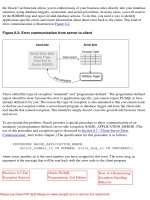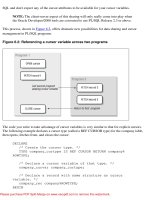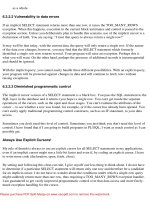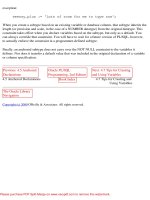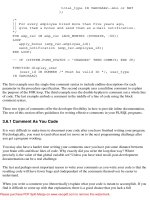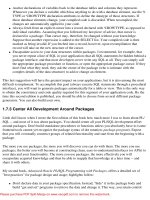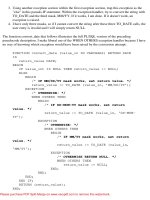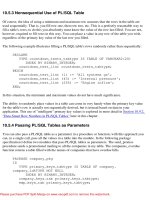jQuery Pocket Reference pdf
Bạn đang xem bản rút gọn của tài liệu. Xem và tải ngay bản đầy đủ của tài liệu tại đây (3.21 MB, 158 trang )
jQuery
Pocket Reference
jQuery
Pocket Reference
David Flanagan
Beijing
•
Cambridge
•
Farnham
•
Köln
•
Sebastopol
•
Tokyo
jQuery Pocket Reference
by David Flanagan
Copyright © 2011 David Flanagan. All rights reserved.
Printed in the United States of America.
Published by O’Reilly Media, Inc., 1005 Gravenstein Highway North,
Sebastopol, CA 95472.
O’Reilly books may be purchased for educational, business, or sales promo-
tional use. Online editions are also available for most titles (ari
booksonline.com). For more information, contact our corporate/institutional
sales department: (800) 998-9938 or
Editors: Mike Loukides and Simon St. Laurent
Production Editor: Teresa Elsey
Proofreader: Marlowe Shaeffer
Indexer: Ellen Troutman Zaig
Cover Designer: Karen Montgomery
Interior Designer: David Futato
Printing History:
December 2010: First Edition.
Nutshell Handbook, the Nutshell Handbook logo, and the O’Reilly logo are
registered trademarks of O’Reilly Media, Inc. The Pocket Reference series
designation, jQuery Pocket Reference, the image of a rufous-necked weaver
bird, and related trade dress are trademarks of O’Reilly Media, Inc.
Many of the designations used by manufacturers and sellers to distinguish
their products are claimed as trademarks. Where those designations appear
in this book, and O’Reilly Media, Inc., was aware of a trademark claim, the
designations have been printed in caps or initial caps.
While every precaution has been taken in the preparation of this book, the
publisher and author assume no responsibility for errors or omissions, or for
damages resulting from the use of the information contained herein.
ISBN: 978-1-449-39722-7
[TG]
1291911712
Contents
Preface ix
Chapter 1: Introduction to jQuery 1
jQuery Basics 3
The jQuery() Function 4
Queries and Query Results 8
Chapter 2: Element Getters and Setters 13
Getting and Setting HTML Attributes 14
Getting and Setting CSS Attributes 15
Getting and Setting CSS Classes 16
Getting and Setting HTML Form Values 17
Getting and Setting Element Content 18
Getting and Setting Element Geometry 19
Getting and Setting Element Data 22
Chapter 3: Altering Document Structure 25
Inserting and Replacing Elements 25
Copying Elements 28
Wrapping Elements 29
Deleting Elements 29
v
Chapter 4: Events 31
Simple Event Handler Registration 31
jQuery Event Handlers 34
The jQuery Event Object 34
Advanced Event Handler Registration 37
Deregistering Event Handlers 39
Triggering Events 41
Custom Events 44
Live Events 45
Chapter 5: Animated Effects 49
Simple Effects 52
Custom Animations 53
Canceling, Delaying, and Queuing Effects 58
Chapter 6: Ajax 63
The load() Method 63
Ajax Utility Functions 66
The jQuery.ajax() Function 72
Ajax Events 80
Chapter 7: Utility Functions 83
Chapter 8: Selectors and Selection Methods 89
jQuery Selectors 89
Selection Methods 95
Chapter 9: Extending jQuery with Plugins 103
Chapter 10: The jQuery UI Library 109
Chapter 11: jQuery Quick Reference 113
Factory Function 113
vi | Table of Contents
Selector Grammar 114
Basic Methods and Properties 115
Selection Methods 117
Element Methods 120
Insertion and Deletion Methods 123
Event Methods 126
Effects and Animation Methods 129
Ajax Functions 131
Utility Functions 134
Index 139
Table of Contents | vii
Preface
This book covers version 1.4 of the jQuery library for client-
side JavaScript programming. It is one chapter from my much
longer book JavaScript: The Definitive Guide. jQuery is such a
powerful library and so well suited to pocket reference format
that it seemed worth publishing this material on its own.
This book assumes that you already know how to program
with JavaScript, and that you are familiar with the basics of
client-side JavaScript programming without jQuery. For ex-
ample, you should know about DOM methods like getElement
ById(), getElementsByTagName(), and addEventListener().
Thanks to Raffaele Cecco for a timely and thorough review of
the book and of the code it contains. Thanks also to John Resig
and the entire jQuery team for creating such a useful library,
to my editor Mike Loukides for his enthusiasm for this project,
and to the O’Reilly production department for getting this
book out so quickly.
The examples in this book can be downloaded from the book’s
web page, which will also include errata if any errors are dis-
covered after publication:
/>ix
In general, you may use the examples in this book in your pro-
grams and documentation. You do not need to contact us for
permission unless you’re reproducing a significant portion of
the code. We appreciate, but do not require, an attribution
like this: “From jQuery Pocket Reference by David Flanagan
(O’Reilly). Copyright 2011 David Flanagan,
978-1-449-39722-7.” If you feel your use of code examples falls
outside fair use or the permission given here, feel free to contact
us at
To comment or ask technical questions about this book, send
email to:
This book is also available from the Safari Books Online serv-
ice. For full digital access to this book and others on similar
topics from O’Reilly and other publishers, sign up at http://
my.safaribooksonline.com.
x | Preface
CHAPTER 1
Introduction to jQuery
JavaScript has an intentionally simple core API and an overly
complicated client-side API that is marred by major incompa-
tibilities between browsers. The arrival of IE9 eliminates the
worst of those incompatibilities, but many programmers find
it easier to write web applications using a JavaScript framework
or utility library to simplify common tasks and hide the differ-
ences between browsers. At the time of this writing, jQuery is
one of the most popular and widely used of these libraries.
Because it has become so widely used, web developers should
be familiar with the jQuery library: even if you don’t use it in
your own code, you are likely to encounter it in code written
by others. Fortunately, jQuery is stable and small enough to
document in pocket reference form.
jQuery makes it easy to find the elements of a document, and
then manipulate those elements by adding content, editing
HTML attributes and CSS properties, defining event handlers,
and performing animations. It also has Ajax utilities for dy-
namically making HTTP requests, and general-purpose utility
functions for working with objects and arrays.
As its name implies, the jQuery library is focused on queries.
A typical query uses a CSS selector to identify a set of document
elements and then returns an object that represents those ele-
ments. This returned object provides many useful methods for
1
operating on the matching elements as a group. Whenever
possible, these methods return the object on which they are
invoked, allowing a succinct method-chaining idiom to be
used. These features are at the heart of jQuery’s power and
utility:
• An expressive syntax (CSS selectors) for referring to
elements in the document
• An efficient query method for finding the set of document
elements that match a CSS selector
• A useful set of methods for manipulating selected
elements
• Powerful functional programming techniques for operat-
ing on sets of elements as a group, rather than one at a time
• A succinct idiom (method chaining) for expressing
sequences of operations
This book begins with an introduction to jQuery that shows
how to make simple queries and work with the results. The
chapters that follow explain:
• How to set HTML attributes; CSS styles and classes;
HTML form values; and element content, geometry, and
data
• How to alter the structure of a document by inserting,
replacing, wrapping, and deleting elements
• How to use jQuery’s cross-browser event model
• How to produce animated visual effects with jQuery
• jQuery’s Ajax utilities for making scripted HTTP requests
• jQuery’s utility functions
• The full syntax of jQuery’s selectors, and how to use
jQuery’s advanced selection methods
• How to extend jQuery by using and writing plugins
• The jQuery UI library
The end of this book is a quick reference to all of jQuery’s
methods and functions.
2 | Chapter 1: Introduction to jQuery
jQuery Basics
The jQuery library defines a single global function named
jQuery(). This function is so frequently used that the library
also defines the global symbol $ as a shortcut for it. These are
the only two symbols jQuery defines in the global namespace.
*
This single global function with two names is the central query
function for jQuery. Here, for example, is how we ask for the
set of all <div> tags in a document:
var divs = $("div");
The value returned by this function represents a set of zero or
more DOM elements and is known as a jQuery object. Note
that jQuery() is a factory function rather than a constructor: it
returns a newly created object, but it is not used with the new
keyword. jQuery objects define many methods for operating
on the sets of elements they represent, and most of this book
is devoted to explaining those methods. Below, for example, is
code that finds, highlights, and quickly displays all hidden
<p> tags that have a class of “more”:
$("p.more").css("background-color", "gray").show("fast");
The css() method operates on the jQuery object returned by
$(), and returns that same object so that the show() method
can be invoked next in a compact “method chain”. This
method-chaining idiom is common in jQuery programming.
As another example, the code below finds all elements in the
document that have the CSS class “hide”, and registers an event
handler on each one. That event handler is invoked when the
user clicks on the element, making it slowly “slide up” and
disappear:
$(".hide").click(function() { $(this).slideUp("slow"); });
* If you use $ in your own code, or are using another library—such as
Prototype—that uses $, you can call jQuery.noConflict() to restore $ to its
original value.
jQuery Basics | 3
Obtaining jQuery
The jQuery library is free software you can download from
. Once you have the code, you can include it
in your web pages with a <script> tag:
<script src="jquery-1.4.4.min.js"></script>
At the time of this writing, the current version of jQuery is
1.4.4. The “min” in the filename above indicates that this is
the minimized version of the library, with unnecessary com-
ments and whitespace removed, and internal identifiers re-
placed with shorter ones.
Another way to use jQuery in your web applications is to allow
a content distribution network to serve it using a URL like one
of these:
/> /> />Replace the “1.4.4” version number in the URLs above as nec-
essary. If you use the Google CDN, you can use “1.4” to get
the latest release in the 1.4.x series, or just “1” to get the most
current release less than 2.0. The major advantage of loading
jQuery from well-known URLs like these is that because of
jQuery’s popularity, visitors to your website will likely already
have a copy of the library in their browser’s cache and no
download will be necessary.
The jQuery() Function
The jQuery() function (a.k.a. $()) is the most important one
in the jQuery library. It is heavily overloaded, however, and
there are four different ways you can invoke it.
The first and most common way to invoke $() is to pass a CSS
selector (a string) to it. When called this way, it returns the set
of elements from the current document that match the selector.
4 | Chapter 1: Introduction to jQuery
jQuery supports most of the CSS3 selector syntax, plus some
extensions of its own. Complete details of the jQuery selector
syntax are in “jQuery Selectors” on page 89. If you pass an
element or a jQuery object as the second argument to $(), it
returns only matching descendants of the specified element (or
elements). This optional second argument value defines the
starting point (or points) for the query and is often called the
context.
The second way to invoke $() is to pass it an Element, Docu-
ment, or Window object. Called like this, it simply wraps the
element, document, or window in a jQuery object and returns
that object, allowing you to use jQuery methods to manipulate
the element rather than using raw DOM methods. It is com-
mon to see jQuery programs call $(document) or $(this), for
example. jQuery objects can represent more than one element
in a document, and you can also pass an array of elements to
$(). In this case, the returned jQuery object represents the set
of elements in your array.
The third way to invoke $() is to pass it a string of HTML text.
When you do this, jQuery creates the HTML element (or ele-
ments) described by that text and then returns a jQuery object
representing those elements. jQuery does not automatically
insert the newly created elements into the document, but the
jQuery methods described in Chapter 3 allow you to easily in-
sert them where you want them. Note that you cannot pass
plain text when you invoke $() in this way, or jQuery will think
you are passing a CSS selector. For this style of invocation, the
string you pass to $() must include at least one HTML tag with
angle brackets.
When invoked in this third way, $() accepts an optional second
argument. You can pass a Document object to specify the
document with which the elements are to be associated. (If you
are creating elements to be inserted into an <iframe>, for ex-
ample, you’ll need to explicitly specify the Document object of
that frame.) Or, you can pass a second argument that specifies
the names and values of attributes to set on the newly created
elements as an object:
The jQuery() Function | 5
var img = $("<img/>", // Create a new <img> tag
{ src:url, // With this src attribute
alt:desc }); // And this alt attribute
Finally, the fourth way to invoke $() is to pass a function to it.
If you do this, the function you pass will be invoked when the
document has been loaded and the DOM is ready to be ma-
nipulated. It is very common to see jQuery programs written
as anonymous functions defined within a call to jQuery():
jQuery(function() { // Invoked when document has loaded
// All jQuery code goes here
});
You’ll sometimes see $(f) written using the older and more
verbose form: $(document).ready(f).
The function you pass to jQuery() will be invoked with the
document object as its this value and with the jQuery function
as its single argument. This means that you can undefine the
global $ function and still use that convenient alias locally with
this idiom:
jQuery.noConflict(); // Restore $ to its original state
jQuery(function($) {
// Use $ as a local alias for the jQuery object
// Put all your jQuery code here
});
jQuery triggers functions registered through $() when the
“DOMContentLoaded” event is fired, or, in browsers that
don’t support that event, when the “load” event is fired. This
means that the document will be completely parsed, but that
external resources such as images may not be loaded yet. If you
pass a function to $() after the DOM is ready, that function
will be invoked immediately—before $() returns.
The jQuery library also uses the jQuery() function as its name-
space, and defines a number of utility functions and properties
under it. The jQuery.noConflict() function mentioned above
is one such utility function. Others include jQuery.each()
for general-purpose iteration and jQuery.parseJSON() for pars-
ing JSON text. Chapter 7 lists general-purpose utility
6 | Chapter 1: Introduction to jQuery
functions, and other jQuery functions are described through-
out this book.
jQuery Terminology
Let’s pause here to define some important terms and phrases
that you’ll see throughout this book:
“the jQuery function”
The jQuery function is the value of jQuery or of $. This is
the function that creates jQuery objects and registers
handlers to be invoked when the DOM is ready; it also
serves as the jQuery namespace. I usually refer to it as
$(). Because it serves as a namespace, the jQuery function
might also be called “the global jQuery object”, but it is
very important not to confuse it with “a jQuery object”.
“a jQuery object”
A jQuery object is an object returned by the jQuery func-
tion. A jQuery object represents a set of document ele-
ments and can also be called a “jQuery result”, a “jQuery
set”, or a “wrapped set”.
“the selected elements”
When you pass a CSS selector to the jQuery function, it
returns a jQuery object that represents the set of docu-
ment elements matching that selector. When describing
the methods of the jQuery object, I’ll often use the phrase
“the selected elements” to refer to those matching ele-
ments. For example, to explain the attr() method, I
might write, “the attr() method sets HTML attributes
on the selected elements”, rather than a more precise but
awkward description like, “the attr() method sets
HTML attributes on the elements of the jQuery object on
which it was invoked”. Note that the word “selected” re-
fers to the CSS selector and has nothing to do with any
selection performed by the user.
“a jQuery function”
This is a function like jQuery.noConflict() that is defined
in the namespace of the jQuery function. jQuery func-
tions might also be described as “static methods”.
The jQuery() Function | 7
“a jQuery method”
A jQuery method is a method of a jQuery object returned
by the jQuery function. The most important part of the
jQuery library is the powerful methods it defines.
The distinction between jQuery functions and methods is
sometimes tricky because a number of functions and methods
have the same name. Note the differences between these two
lines of code:
// Call the jQuery function each() to invoke the
// function f once for each element of the array a
$.each(a,f);
// Call the jQuery() function to obtain a jQuery
// object that represents all <a> elements in the
// document. Then call the each() method of that
// jQuery object to invoke the function f once for
// each selected element.
$("a").each(f);
The official jQuery documentation at uses
names like $.each to refer to jQuery functions, and names
like .each (with a period but without a dollar sign) to refer to
jQuery methods. In this book, I’ll use the term “function” and
“method” instead. Usually it will be clear from the context that
is being discussed.
Queries and Query Results
When you pass a jQuery selector string to $(), it returns a
jQuery object that represents the set of matched (or “selected”)
elements. jQuery selectors are very much like the CSS selectors
you use in stylesheets. For example:
div // all <div> elements
#surname // the element with id="surname"
.warning // all elements with class="warning"
8 | Chapter 1: Introduction to jQuery
$() vs. querySelectorAll()
The $() function is similar to the Document method
querySelectorAll(): both take a CSS selector as their argument
and return an array-like object that holds the elements that
match the selector. The jQuery implementation uses
querySelectorAll() in browsers that support it, but there are
good reasons to use $() instead of querySelectorAll() in your
own code:
• querySelectorAll() has only recently been implemented
by browser vendors, whereas $() works in older browsers
as well as new ones.
• Because jQuery can perform selections “by hand”, the
CSS3 selectors supported by $() work in all browsers, not
just those browsers that support CSS3.
• The array-like object returned by $() (a jQuery object) is
much more useful than the array-like object (a NodeList)
returned by querySelectorAll().
The specific selector syntax supported by jQuery is detailed in
“jQuery Selectors” on page 89. Rather than focus on those
advanced selector details now, we’re going to first explore what
you can do with the results of a query.
The value returned by $() is a jQuery object. jQuery objects
are array-like: they have a length property and numeric prop-
erties from 0 to length-1. This means that you can access the
contents of the jQuery object using standard square-bracket
array notation:
$("body").length // => 1: documents have only one body
$("body")[0] // This the same as document.body
If you prefer not to use array notation with jQuery objects, you
can use the size() method instead of the length property, and
the get() method instead of indexing with square brackets. If
you need to convert a jQuery object to a true array, call the
toArray() method.
Queries and Query Results | 9
In addition to the length property, jQuery objects have three
other properties that are sometimes of interest. The selector
property is the selector string (if any) that was used when the
jQuery object was created. The context property is the context
object that was passed as the second argument to $(), or the
Document object otherwise. Finally, all jQuery objects have a
property named jquery, and testing for the existence of this
property is a simple way to distinguish jQuery objects from
other array-like objects. The value of the jquery property is the
jQuery version number as a string:
// Find all <script> elements in the document body
var bodyscripts = $("script", document.body);
bodyscripts.selector // => "script"
bodyscripts.context // => document.body
bodyscripts.jquery // => "1.4.2"
If you want to loop over all elements in a jQuery object, call
the each() method instead of writing a for loop. The each()
method is something like the ECMAScript 5 (ES5) forEach()
array method. It expects a callback function as its sole argu-
ment, and invokes that callback function once for each element
in the jQuery object (in document order). The callback is in-
voked as a method of the matched element, so within the call-
back the this keyword refers to an Element object. each() also
passes the index and the element as the first and second argu-
ments to the callback. Note that this and the second argument
are raw document elements, not jQuery objects; if you want to
use a jQuery method to manipulate the element, you’ll need to
pass it to $() first.
jQuery’s each() method has one feature that is quite different
than forEach(): if your callback returns false for any element,
iteration is terminated after that element (this is like using the
break keyword in a normal loop). each() returns the jQuery
object on which it is called so that it can be used in method
chains. Here is an example (it uses the prepend() method that
will be explained in Chapter 3):
// Number the divs of the document, up to div#last
$("div").each(function(idx) { // Invoke for each <div>
// Create a jQuery object from the element
10 | Chapter 1: Introduction to jQuery
// And insert the index at start of it.
$(this).prepend(idx + ": ");
// Stop iterating when we reach #last
if (this.id === "last")
return false;
});
Despite the power of the each() method, it is not very com-
monly used since jQuery methods usually iterate implicitly
over the set of matched elements and operate on them all. You
typically only need to use each() if you need to manipulate the
matched elements in different ways. Even then, you may not
need to call each() since a number of jQuery methods allow
you to pass a callback function.
The jQuery library predates the ES5 array methods and defines
a couple of other methods that provide similar functionality.
The jQuery method map() works much like the Array.map()
method. It accepts a callback function as its argument and in-
vokes that function once for each element of the jQuery object,
collecting the return values of those invocations, and returning
a new jQuery object holding those return values. map() invokes
the callback in the same way as the each() method: the element
is passed as the this value and as the second argument, and
the index of the element is passed as the first argument. If the
callback returns null or undefined, that value is ignored and
nothing is added to the new jQuery object for that invocation.
If the callback returns an array or an array-like object (such as
a jQuery object), it is “flattened” and its elements are added
individually to the new jQuery object. Note that the jQuery
object returned by map() may not hold document elements, but
it still works as an array-like object. Here is an example:
$(":header") // Find all headings.
.map(function() { // Map them to
return this.id; // their ids.
})
.toArray() // Convert to a true array
.sort(); // And sort that array
Along with each() and map(), another fundamental jQuery
method is index(). This method expects an element as its
Queries and Query Results | 11
argument, and it returns the index of that element in the jQuery
object, or -1 if it is not found. In typical jQuery fashion, how-
ever, this index() method is overloaded. If you pass a jQuery
object as the argument, index() searches for the first element
of that object. If you pass a string, index() uses it as a CSS
selector and returns the index of the first element of this jQuery
object in the set of elements matching that selector. And if you
pass no argument, index() returns the index of the first element
within its sibling elements.
The final general-purpose jQuery method we’ll discuss here is
is(). It takes a selector as its argument and returns true if at
least one of the selected elements also matches the specified
selector. You might use it in an each() callback function, for
example:
$("div").each(function() { // For each <div> element
if ($(this).is(":hidden")) // Skip hidden elements
return;
// Do something with the visible ones here
});
12 | Chapter 1: Introduction to jQuery
CHAPTER 2
Element Getters and Setters
Some of the simplest and most common operations on jQuery
objects are those that get or set the value of HTML attributes,
CSS styles, element content, or element geometry. This chapter
describes those methods. First, however, it is worth making
some generalizations about getter and setter methods in
jQuery:
• Rather than defining a pair of methods, jQuery uses a sin-
gle method as both getter and setter. If you pass a new
value to the method, it sets that value; if you don’t specify
a value, it returns the current value.
• When used as setters, these methods set values on every
element in the jQuery object and then return the jQuery
object to allow method chaining.
• When used as a getter, these methods query only the first
element of the set of elements and return a single value.
(Use map() if you want to query all elements.) Since getters
do not return the jQuery object they are invoked on, they
can only appear at the end of a method chain.
• When used as setters, these methods often accept object
arguments. In this case, each property of the object speci-
fies a name and a value to be set.
• When used as setters, these methods often accept func-
tions as values. In this case, the function is invoked to
13

